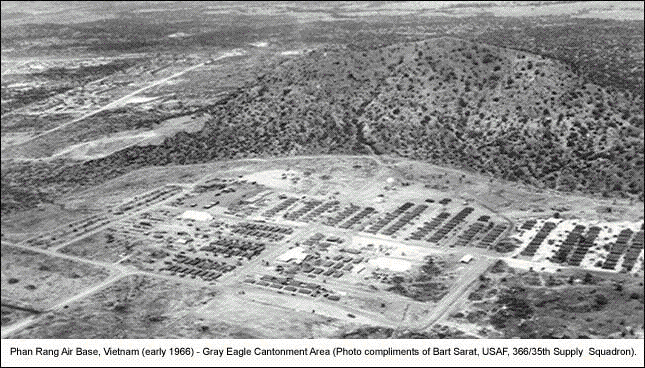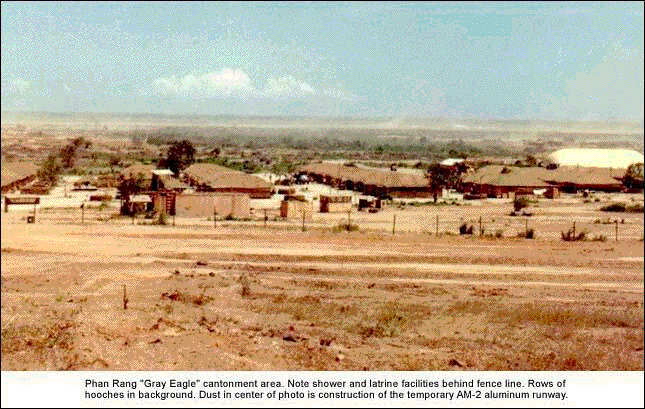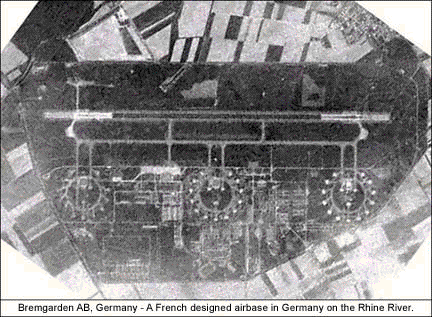| Phan Rang Air Base, Vietnam | home |
| back to Introduction |
| What was Gray Eagle? |
After World War II the Air Force required a capability to commit and rapidly deploy aircraft, support functions and facilities to independently launch and sustain combat operations in a bare base environment. This bare base was defined as a location with a usable runway taxiway parking ramp and a source of water that could be made potable. It required mobile facilities, utilities, and support equipment that could quickly transform the bare location into an operational installation. The original pre-package mobile support equipment was mostly World War II hardware consisting mainly of tents, field kitchens, medical facilities, power generators, cots, desks and other equipment. It was bulky, heavy and required a lot of time to position and set up. This original mobile basing set was designated "Gray Eagle" and was designed to support an 1100-person deployment. The Air Force first used it at Cam Ranh Bay and Phan Rang Air Bases in the mid 1960s during the Vietnam War.

Personnel who were assigned to Phan Rang after 1966 experienced permanent barracks and facilities as construction of the base progressed to completion. The initial cadre of Gray Eagle personnel to arrive at Phan Rang found themselves living in tents that were later converted to hooches (a framed structure with a tent roof). There was no running water, and latrine facilities consisted of outhouses, urinal tubes, and for most of the time cold shower facilities. Messing was done at a field ration mess tent with mess kits rinsed in boiling disinfectant emersion containers after eating. Later the Officers and NCO Clubs were constructed and meals were available there for these personnel. The roads were unpaved, dirt, rough, dusty, muddy and full of potholes that could literally tear a vehicle apart.

We had utilization boards (pronounced UB’s like in tub) for new equipment, i.e., typewriters, vehicles, and even beds. Although equipment identified in base build-up packages was shipped from stateside, receipt of destined equipment came into the three major ports of Saigon, Cam Ranh Bay, and DaNang. Herein laid a major problem in that stateside computers shipped equipment to the war, but no automated capability to record receipt existed in Vietnam. Record keeping was done on manually maintained stock record cards. It wasn't until late 1966 that Air Force installations in South East Asia (SEA) began receiving computerized accountability record keeping systems housed in portable vans.
The base in late 1965 and early 1966 was in its beginning construction phase. The main mission was to prepare the base to receive and operate combat aircraft, as well as pave infrastructure for subsequent construction, development and growth of the base to the large base complex that it would eventually become. Those tasks were to establish command, communications and control; ready a temporary aluminum runway with taxiway and ramp for combat aircraft operations; establish aircraft maintenance facilities; construct and maintain a munitions storage area; and initiate other base projects required for permanent base development.
Phan Rang's original layout and construction planning encompassed a design that was similar to French designed air bases found in Germany along the Rhine River. This design provided separate round marguerite revetted aircraft ramp areas with operations and maintenance facilities at the center. The design was changed to the layout of the base that exists today.

In March 1966 the 366 TFW Headquarters and its 389th TFS (F-4C) aircraft arrived from Holloman Air Force Base, New Mexico. This was the first Air Force combat unit to operate at Phan Rang. Four squadrons of F-100 aircraft began arriving shortly after the F-4C aircraft in May - September 1966. In October 1966 the 35th TFW at Da Nang Air Base, swapped locations with the 366th TFW. Only a few years after the Gray Eagle period (65-66) Phan Rang would become one of the largest air bases in Southeast Asia hosting a variety of combat and support mission aircraft. The multinational forces included American, South Vietnamese, Australians, and Korean personnel.

Phan Rang is now a Vietnamese Air Force Base with Soviet built jet fighters parked in revetments built by US forces. Included throughout this website are pictures of the Phan Rang Air Base "Gray Eagle" era.
Additional early "Gray Eagle" and later Phan Rang images of the base can be found at links I have indicated.
